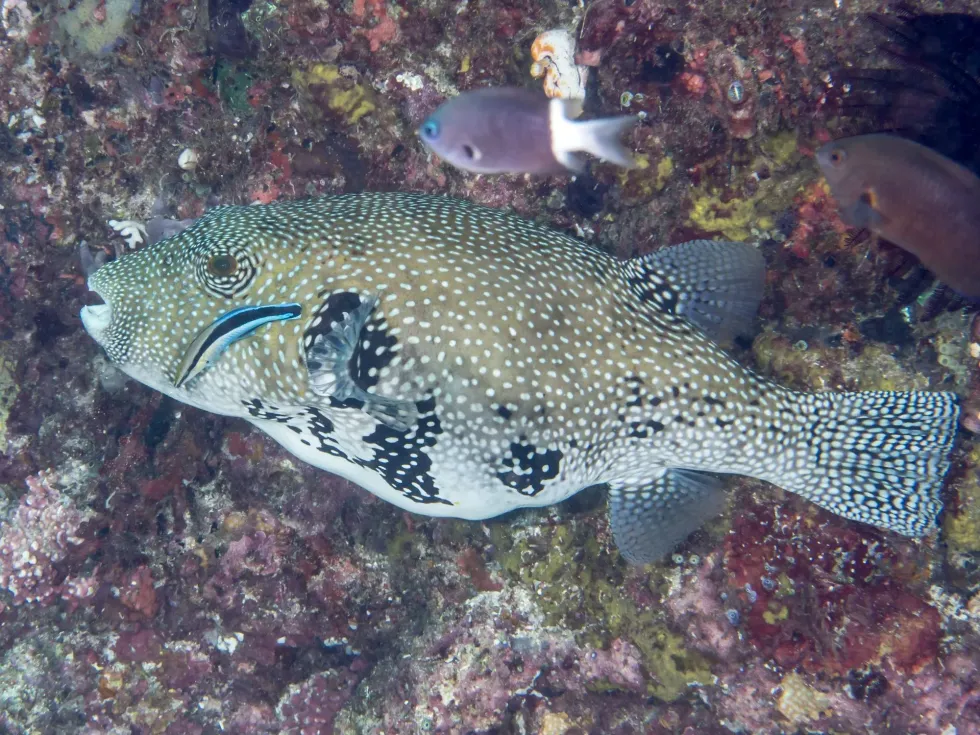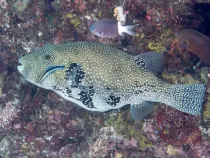Map puffer-fish, also known as scribbled puffer, scribbled toadfish, Arothron puffer, and Kesho-fugu, is a marine fish species found between the Indian Ocean and the Pacific Ocean. The family of the map pufferfish is Tetraodontidae.
It is a well-known marine species, which is also easy to distinguish from other fish species because of the different map patterns present on their skin. The map puffer is usually seen swimming around the coral reef.
Map Pufferfish is a white and black colored fish with strong teeth that never stop growing in entire life. The reproduction is oviparous, which means the male fertilizes the eggs outside of the female body.
Both males and females eat invertebrates, but in an aquarium, they also feed on manufactured foods. The aquarium should be large because of the puffer's potential to swells up.
You can also check out many interesting facts about other marine species such as lesser electric ray facts and blue-spotted puffer facts.
Map Puffer Interesting Facts
What type of animal is a Map Puffer?
The map puffer, or scribbled toadfish, is a pufferfish species in the family Tetraodontidae.
What class of animal does a Map Puffer belong to?
The map puffer (Arothron mappa) is a marine fish species that belongs to the class Actinopterygii and phylum Chordata.
How many Map Puffers are there in the world?
The total population of scribbled map puffers has not been estimated yet.
Where does a Map Puffer live?
Map puffers usually reside in tropical and subtropical waters between the western Pacific Ocean and the Indian Ocean. In addition to the Indo-Pacific region, this fish is also found in New Caledonia, Queensland (Australia), Samoa, South Africa, East Africa, Natal, Ryukyus, and the western sea of Japan.
What is a Map Puffer's habitat?
Map puffers prefer tropical and subtropical marine waters. Juveniles prefer to live near seagrass beds across the Indo-Pacific area.
Alternatively, the adults can be found offshore, in sheltered reefs, and clear lagoons, from the surface to 98.4 ft (30 m) deep. They can also be found among reefs of corals, resting or waiting for their prey. As its food is mostly available on reef tops, it can be easily found there.
Who does a Map Puffer live with?
The map puffer is a diurnal fish and generally exhibits solitary behavior.
How long does a Map Puffer live?
The average lifespan of any puffer species is around 10 years. However, the total life expectancy of map puffers is unknown.
How do they reproduce?
Among map puffer species, the courtship display involves the building of a massive flattened circle in a substrate by the male. It uses its fins to dig and stir up dust particles.
After that, the male puffer digs geometric channels and elevations within a circle to form a complex and maze-like pattern. This activity attracts the female puffers.
The site also acts as a site for eggs to be laid. When a female map puffer comes near the nest, the male will swim around and throw the sand to pull the attention of the female. After a successful courtship ritual, the female will lay her eggs in the nest.
Then the eggs are fertilized by the male map puffer. These fertilized eggs will stay and grow inside the nest until they hatch into larvae.
What is their conservation status?
The conservation status of map puffers is listed as Least Concern by the IUCN.
Map Puffer Fun Facts
What does the Map Puffer look like?

The map puffer, also known as Arothron puffer, is a medium-sized fish that grows up to 25.5 in (65 cm) length and attains a maximum weight of about 14.3 lb (6.5 kg). It has an oval, yet relatively elongated, scaleless body.
The maximum map of the puffer's body is covered with diminutive dermal spines with the exclusion of regions around the mouth, caudal-fin base, and pectoral-fin base. The Arothron puffer has no lateral lines or pelvic fins.
However, the anal fin and dorsal fin are tiny, symmetric, and positioned at the end of the body. The fish possesses two pairs of nostrils and four strong teeth in the mouth, which are fused together to form an edged beak.
These teeth continuously grow entire life.
However, they become pale with the consumption of hard-shelled prey. The fish background is white with a thick network of brown, black, or green broken lines.
In Tanzania, the background is yellow. Although, in some species, there is the occurrence of dark or yellow spots around the mouth, anus, fins, or somewhere else in the body.
The fish can move its eyes separately and has good vision. Another unique feature in the fish is that it has the ability to fill its stomach with the water and swells up so that it becomes harder for a predator to fit in its mouth.
How cute are they?
Map puffers are medium-sized fish that look extraordinarily cute when they swell up. Therefore, it can be mesmerizing to watch them in an aquarium.
How do they communicate?
There is not much information available regarding their means of communication. However, they scare off predators by throwing poison on them.
How big is a Map Puffer?
The total length of a pufferfish is around 25.5 in (65 cm) max, which is 17 times larger than a toadfish.
How fast can a Map Puffer swim?
The swimming speed of the map puffer is unknown.
How much does a Map Puffer weigh?
The maximum weight of a scribbled puffer is 14.3 lb (6.5 kg), which is seven times heavier than a drum fish.
What are the male and female names of the species?
There are no specific names for male and female scribbled pufferfish.
What would you call a baby Map Puffer?
The map puffer baby is generally known as a young or a juvenile.
What do they eat?
Arothron puffer's diet includes benthic invertebrates, mussels, anchovies, sponges, crustaceans, and algae. They have powerful ever-growing teeth to feed on their food. In an aquarium or tank, their diet also includes commercial meaty foods.
Are they dangerous?
Arothron puffers contain tetrodotoxin which is a notable toxic sodium channel that protects them from predators. However, puffers do not secrete poison themselves; instead, it is secreted by endosymbiotic bacteria that live in the pufferfish.
Despite their toxicity, the fish species is considered an important delicacy in Japan.
However, only the flesh is edible; other organs like the skin, gonads, liver, and intestines should not be consumed as they consist of a high amount of tetrodotoxin. However, those raised on farms in Japan are provided with a controlled diet, meaning they are less poisonous and primed for human consumption.
Would they make a good pet?
Map pufferfish are a toxic species. Despite this, people love to keep them as pets in the aquarium and tank. They can be easily found both in the aquarium trade and specific food shops.
These fish are kept by some aquarists, but due to their continuously growing teeth, they need regular feeds on hard-shelled crustaceans, which temporarily prevent the teeth from developing too far. Although map pufferfish are non-aggressive, they can attack smaller sickly fishes in the aquarium or tank.
Pufferfish need a large tank or aquarium because of their potential size. They feed on invertebrates and meaty foods in a tank or aquarium. They can also damage coral in the aquarium.
Did you know...
Arothron puffer, or map puffer, species are in a parasitic relationship with several invertebrates. Some of them include the Aporocotylidae species of Psettarium yoshidai and two nematode species, Philometra robusta and Philometra pellucida.
The aforementioned Philometra species produce intense swelling and expansion of the intestine in Tetraodontiformes. Cases of excessive contamination and bloating as a result of Philometra in pufferfish can cause their fast ascension to surface waters and resulting predation because of loss of safe home and mobility.
Why is it called Map Puffer?
The map puffer got its name from the map-like patterns on its skin.
How many hearts does a Puffer Fish have?
Pufferfish have only one heart.
Here at Kidadl, we have carefully created lots of interesting family-friendly animal facts for everyone to discover! Learn more about some other fishes from our northern puffer facts and bandtail puffer facts pages.
You can even occupy yourself at home by coloring in one of our free printable Map puffer coloring pages.









